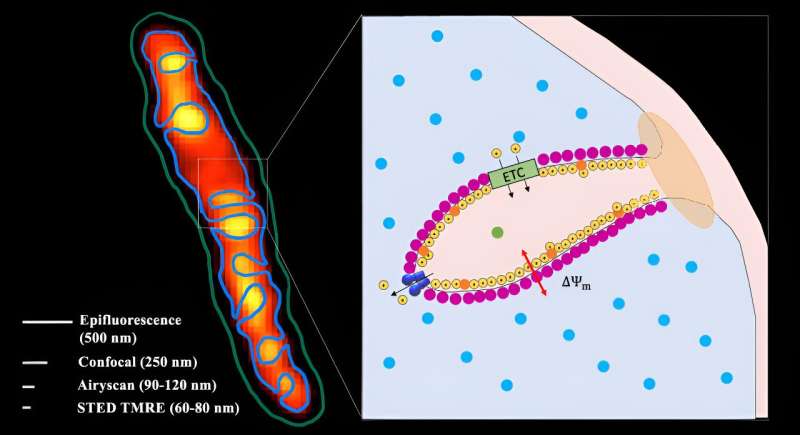This article has been reviewed according to Science X's editorial process and policies. Editors have highlighted the following attributes while ensuring the content's credibility:
fact-checked
peer-reviewed publication
trusted source
proofread
Researchers uncover battery-like functions of mitochondria using super-resolution microscopes

Using new super-resolution microscopes, researchers at the University of California, Irvine and the University of Pennsylvania have for the first time observed electrical charge and discharge functions inside mitochondria isolated from cells.
A mitochondrion is a structure within a cell that uses aerobic respiration to generate adenosine triphosphate, an organic compound that provides energy to support many processes in living tissues. Medical and biomedical engineering researchers have sought greater understanding of mitochondria, recognizing their importance in human health and disease.
While many past research projects have studied the physical characteristics of these components as they exist within living cells, the UCI-led project is the first to use super-resolution microscopes to study live, extracellular mitochondria. By observing the changes in the mitochondrial membranes under different metabolic states this way, the researchers were able to witness the electrophysiological functioning of these living organelles. The team's results were published in the journal ACS Nano.
"When we first started studying isolated mitochondria, we knew they behaved like a battery based on some work from the Tokyo Metropolitan Institute of Gerontology and UCLA, but we could not control them very well inside the cell to probe them," said co-author Peter Burke, UCI professor of electrical engineering and computer science. "Now we can control each individual electrical component and cause it to charge and discharge."
He said the work was made possible by a new generation of super-resolution microscopes. Team members used all three leading methods—Airy microscopy, stimulated emission depletion microscopy and lattice structured illumination microscopy—in their study.
This enabled them to examine cristae, repeating serpentine structures within mitochondria that measure about 100 nanometers. The shortest wavelength of visible light is violet at about 380 nanometers, Burke said, so they needed powerful instruments—super-resolution microscopes—to probe the voltage distribution of something less than a third of that size.
"Imagine trying to study how the battery pack in a Tesla works, but you can only do it by driving the car," he said. "You would not learn much about the battery pack inside the car."
By taking mitochondria out of the cell and keeping them alive, Burke and his collaborators—
lead author ChiaHung Lee, UCI graduate student researcher in biomedical engineering, and Douglas Wallace of the University of Pennsylvania—were able to charge and discharge them.
"We could observe in detail how each individual part behaved as a single battery, much like how battery packs in drones and cars—which are many smaller batteries—individually combine to power the vehicle," Burke said. "Interestingly, we found that the batteries rearrange themselves when they charge and discharge, a feature not found in regular batteries."
He noted that his experiments proved what researchers had long thought while studying snapshots of frozen (dead) mitochondria: The internal structure changes in response to the metabolic needs of the cell. A mitochondrion can create and destroy its "batteries" (cristae) as needed. This shows that, unlike drones and Teslas, mitochondria can alter their internal shapes based on how much energy is needed by cells.
Burke said this work could have broad applications in human health, including studies on how humans age at the cellular level.
"Once we understand how they create energy, we can start to think of ways to modify this for improving human health and longevity," he said.
More information: ChiaHung Lee et al, Super-Resolution Imaging of Voltages in the Interior of Individual, Vital Mitochondria, ACS Nano (2023). DOI: 10.1021/acsnano.3c02768
Journal information: ACS Nano
Provided by University of California, Irvine





















